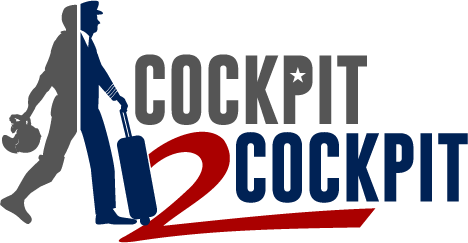
You are probably familiar with the concept of the time-value of money. The earlier you invest your money the more that money will be worth in the future due to the compounding returns it will produce over time. The same concept applies to your military aviation career with respect to making a successful airline transition. Most of us don’t think about our airline transition until we are within a couple years of submitting our applications. If you wait that long, you’re actually putting yourself behind the power curve, a place that no pilot likes to be.
There are many things you should be doing now to prepare for a future career with the airlines because the time-value of a military pilot’s career also pays greater dividends by investing early. It doesn’t matter if you just pinned on your wings or you’re about to pin on O-4, the sooner you start preparing, the more likely you are to succeed in your airline transition when the time comes.
There are so many things I learned in my airline transition, at the end of my military career, that I wish I had known from the day I graduated Undergraduate Pilot Training (UPT). Had I known these things back then, I certainly would have done some things differently from the beginning to make my transition easier in the end. The earlier you begin planning, the more likely you are to have a successful transition when the time comes. Here is a list of five things you can and should be doing right now to help set yourself up for success in your future airline transition.
1. Keep a logbook
It’s not for the interview; it’s for the applications. The main reason to keep your own logbook, opposed to relying on your military flight records, is that airline applications require more details about your flight times than military flight records provide. For instance, military flight records log “primary time” (a category of flight time only used by the military) but they don’t record Pilot in Command (PIC) time. The airlines will want to know how much PIC time you have. The airlines consider PIC time as time logged as captain or aircraft commander, or the person who retains overall authority for the safety of the aircraft. In order to make your airline transition much easier when the time comes, you should log your flight times in your personal logbook in accordance with the way airlines consider flight time on their applications.
There are several other categories of flight times that will be needed for your airline applications that are not logged in your military flight records. A few examples include cross-country time, number of instrument approaches, turbine-PIC time, number of landings, etc. There are plenty of pilots who get hired by the airlines without having a personal logbook but they had to make gross generalizations and use made up rules-of-thumb when filling out their applications. I don’t know about you, but I would be sweating bullets in an interview knowing that I had to fudge a lot of the flight times I listed on my application.

There are two different ways to keep a personal logbook. There’s the old-fashioned paper logbook and there are electronic logbooks. They each have advantages and disadvantages. In my book, Cockpit to Cockpit (www.cockpit2cockpit.com), I dedicate an entire chapter to the subject of logbooks and I don’t want to (and you probably don’t want me to) regurgitate it all here so I will just give you the bottom line. I’m a fan of the electronic logbook because it makes filling out any airline application’s flight times section a breeze. You can easily use the filters of an electronic logbook to come up with any flight time category the application requires in a matter of seconds.
I am a fan of Logbook Pro for PC users or LogTen Pro for Mac users. There are other options and if you want to read a more detailed article about the pros and cons of each, read the article Logbook Battle Royale written by Jason Depew on the website www.aviationbull.com
2. Build as much flight time as possible
I think it goes without saying (but I will say it anyway), that flying hours are a key discriminator that airlines use to screen applications and résumés. No matter what impressive duty titles you rack up in your military career, at the end of the day, the airlines are hiring you to be a pilot. Therefore, they are looking to hire pilots whose flying hours in the military reflect their love of flying, in general. The airlines are all about the bottom line. An airline doesn’t make money with airplanes sitting on the ground, so it should come as no surprise that they want to hire pilots who fly for the pure joy of flying, not just to earn a paycheck.
So how do you maximize your flying hours in the military? First, try to limit your nonflying assignments. I know; that’s usually out of your control, right? We can’t all be fortunate enough to stay in the cockpit our entire military careers, as Idid. (“Don’t hate me because I’m beautiful.”) Sometimes the long arm of the Air Force Personnel Center (AFPC), or your service equivalent of AFPC, yanks you out of the cockpit. If you see the writing on the wall, consider volunteering for the shortest nonflying assignment possible. In the Air Force, that usually meant volunteering for a remote ALO (air liaison officer) tour with the Army. That would usually get you back in the cockpit in two years, and if you volunteered, AFPC would often let you choose your follow-on assignment. White jet assignments (teaching UPT) are another great way to build some hours. It seems that every UPT squadron is always behind the timeline and needs IPs to fly the maximum amount.
The best way to ensure the maximum number of flying assignments in your career is to upgrade quickly in your weapon system. Once you become an IP in your aircraft, you become very valuable to your flesh peddler at the Headquarters Personnel Center. Flying squadrons are usually short on experienced pilots. If you can upgrade to IP before you get yanked out of the cockpit for a nonflying assignment, chances are much higher that you will return to a flying assignment at the earliest opportunity, because the flesh peddler needs to send experienced pilots back to the flying units to keep them healthy. Non-flying assignments used to be the norm after your first or second flying assignment, but in the past year, things have changed a lot due to the pilot retention problem (dare I say “crisis”) the military is facing.
On a more tactical level, there are some good ways to build your time in the air within each flying assignment. A highly effective trick I’ve found is to show up to work early and “hawk” the duty desk on those O’dark thirty sortie briefings. More often than not, someone else will call in sick or oversleep, and they will need a pilot to fill in. There you will be…ready to go! If it doesn’t work and you don’t get to fly that day, tell your operations officer or executive officer that you want to sit in on the mission briefing anyway to prepare for your next upgrade. You can quickly become the rock-star young pilot in your unit this way!
Deployments are another great way to build flying time fast as well as building valuable combat time. The ops tempo down range is usually pretty intense, and you can rack up hours at a much faster rate than when you’re at home station. Besides, it feels very satisfying to be doing the real-world mission and knowing you’re doing your part for the war effort. You’ll come home with some great war stories that work great at a bar on Friday night or in an airline interview when they ask, “So tell me about a time…” and you fire back with, “There I was, in the shit, inverted, air medals all up in my face, when all of a sudden…” You see where I’m going with this?
3. Collect FAA flight ratings/certificates
Even if you never intend to fly on the civilian or general aviation (GA) side, you will want to acquire as many of your civilian flight ratings as possible before applying to the airlines. Obviously, you will need to obtain an Airline Transport Pilot (ATP) certificate to get hired, but it also looks good to get as many other certificates as possible that are not required, because it shows you are “well rounded” in terms of your flying experience. In short, it makes you look like more of a professional pilot. Some of those ratings include certified flight instructor instrument airplane (CFII), multi engine instructor (MEI), tail wheel endorsement, airplane single/multi engine sea (ASES/AMES), rotary, glider, and even balloon pilot.
Another good reason to seek as many ratings as possible is to add more points to your application. Filling out an airline application is much like getting promoted in the military. You‘ll want to check as many boxes as possible. As officers, we know that the chances of getting promoted without completing the appropriate level of professional military education (PME) and without holding certain key duty titles are pretty slim. The same principle applies when filling out an airline-pilot application. You have to check the right boxes.
In 2009, the FAA updated the Code of Federal Regulations (CFR) and made it significantly easier for military pilots to get FAA pilot certificates and ratings via the Military Competency Test (MCT) system (CFR 61.73).
Now military pilots can simply pass a written test and show proof of military flight training to obtain a commercial certificate, instructor certificate, multiengine rating, or instrument rating, from the FAA if they hold the equivalent military rating. That’s right, no civilian flight training or check ride required. How cool is that?
There is a fantastic website that offers MCT preparation courses online called Sheppard Air (http://www.sheppardair.com). Their study method is simple, efficient, and designed to make sure you pass the test. Just as Cockpit to Cockpit is the “gouge” on the airline transition process, Sheppard Air’s MCT-preparation service is the “gouge” on passing the test. They will even refund your money if you don’t pass the MCT. I have used their service, and it works great.
4. Start a journal of stories
When you finally sit down for that airline interview that you worked so hard for, they are going to ask you a bunch of “Tell me about a time” (TMAAT) stories. If you’re anything like I am, you may have a hard time remembering stories from early on in your career, especially if you go the full twenty years or beyond. Hell, I have a hard time remembering what I had for breakfast yesterday, let alone a story from fifteen to twenty years ago. So I recommend you start keeping a TMAAT journal of stories that happen to you throughout your military career. The stories can be things that happened while flying or while performing your nonflying job on the ground. They can even be from before your military career. This is one of those “I wish somebody had told me to do this when I was going through pilot training” pieces of good advice that will definitely pay off in an interview.
Here is a list of the type of stories for which you should keep a journal-record. This list is not all-inclusive but is a good cross section of the type of TMAAT questions you will see in an interview:
- In-flight emergencies: Note the details regarding weather, type of mission, good crew resource management (CRM) actions taken, and so on.
- Safety: Note what was unsafe and what you did about to mitigate the situation.
- Conflict: Any story that paints you in a positive light regarding conflict resolution. It could be about conflict between you and a subordinate/peer/superior or how you dealt with a conflict between other crewmembers/coworkers. Hint: they like to see things handled at the lowest level.
- You had to break a rule or saw somebody break a rule and what you did about it.
- Leadership stories.
- Teamwork stories.
- Customer-service stories: In the military, the customer could be your student pilot if you’re an IP, ground forces if you supported them from the air, the receiver if you fly air refuelers, and so on. Be creative.
- Empathy stories.
- Innovation, creativity, or improvisation stories.
- CRM stories (try to weave examples of CRM into all stories if you can).
All the topics included in the list above are important qualities that the airlines are looking for in a pilot. Most of us can come up with enough to cover at least one story for each of the topics above. However, some airlines will really dig in on a particular topic that may be one of their core values. If they ask you three customer-service stories, will you have enough without having kept a journal throughout your time as a military pilot? Probably not.
5. Volunteer
Volunteering your time and resources to a good cause is something that should come naturally. It feels great to help those in need; teach a kid about aviation, mentor a high-risk youth and see him or her get back on the right track, and so on. It’s very easy to become so consumed in our own world, both at work and at home, that we forget the basic principal of “love thy neighbor.” Do your best to seek out and make time for volunteer opportunities throughout your military career.
Here are just a few suggestions of some of the more common places you can volunteer, but this list is, by no means, all-inclusive. Any good cause you believe in is a good place to volunteer: Habitat for Humanity, Red Cross, the Humane Society, Civil Air Patrol, the Order of Daedalians, Young Eagles, your local church or place of worship … the list goes on and on.
Volunteering also has a couple of side benefits for a military pilot with hopes of becoming an airline pilot — it separates you from the pack. While you are still active duty, it will greatly increase your chances of garnering those quarterly and annual officer awards such as Company Grade Officer of the Quarter or Field Grade Officer of the Year. In the Air Force, individual award packages are submitted to an awards board. If the board has to decide between two officers who were virtually equal in their job performance, guess what. The award will almost always be given to the officer who has stronger volunteer activities.
The same concept applies when it comes to getting hired at the airlines. The HR folks will screen thousands of applications and résumés for each pilot position. The competition is fierce. Those volunteer activities may make all the difference in \getting an interview instead of the other guy/gal. In my experience, it seems that volunteer work is especially important to American Airlines, Southwest Airlines, and JetBlue Airways. That doesn’t mean the other airlines don’t value volunteer work, but I have definitely heard from hiring officials, with the aforementioned three airlines, that volunteer work will help you get hired.
These are just some of the things you can be doing from the day you proudly pin on the wings of a military aviator that will not only enhance your career in the military, they will also set you up for success in your eventual airline transition. Just as the value of money invested early in your career will appreciate over time, so too will the efforts made throughout your time in uniform pay dividends later in your commercial career. For other tips and a wealth of knowledge about the military to airline transition process, please visit www.cockpit2cockpit.com






















































